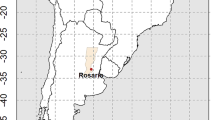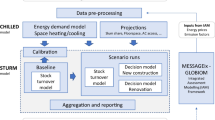Abstract
Inverse modeling is a common method to predict electricity consumption in buildings. Residential building electricity consumption patterns can vary significantly due to occupants and their sporadic energy-consuming behaviors, as well as due to variations in HVAC system types and characteristics across climate zones. However most data-driven methods in this area have been developed and evaluated using limited datasets. This points to the need for an understanding of how well data-driven models perform using residential energy consumption data from a range of locations and home types using a diverse dataset. Thus in this research, first, inverse change-point modeling methods are used to develop predictive models of monthly electricity use for 3,643 houses in four U.S. cities in three ASHRAE climate zones (2A, 4A, 5A), to evaluate the model performance. However, approximately 40% of homes did not fit within recommended criteria for change-point model development following a common model development sequence. Therefore, a modified version of the sequence, including a segmented change-point model, is then developed and evaluated. Change-point models with relaxed prerequisite criteria are also used to enable the fitting of models to a larger number of homes’ data. As a result of these modifications, the number of homes with models increased from 60% to 71%, with a goodness-of-fit improvement of 13% (RMSE) and 8% (CV-RMSE) across the datasets evaluated. The results of this work enable improved prediction of energy use across a diversity of buildings and climate zones.
Similar content being viewed by others
References
Abushakra B, Paulus MT (2016a). An hourly hybrid multi-variate change-point inverse model using short-term monitored data for annual prediction of building energy performance, part I: Background (1404-RP). Science and Technology for the Built Environment, 22: 976–983.
Abushakra B, Paulus MT (2016b). An hourly hybrid multi-variate change-point inverse model using short-term monitored data for annual prediction of building energy performance, part II: Methodology (1404-RP). Science and Technology for the Built Environment, 22: 984–995.
Abushakra B, Paulus MT (2016c). An hourly hybrid multi-variate change-point inverse model using short-term monitored data for annual prediction of building energy performance, part III: Results and analysis (1404-RP). Science and Technology for the Built Environment, 22: 996–1009.
Ahmad AS, Hassan MY, Abdullah MP, Rahman HA, Hussin F, Abdullah H, Saidur R (2014). A review on applications of ANN and SVM for building electrical energy consumption forecasting. Renewable and Sustainable Energy Reviews, 33: 102–109.
ASHRAE (2014). ASHRAE Guideline 14 - 2014. Measurement of Energy and Demand Savings. Atlanta, GA, USA: The American Society of Heating, Refrigerating and Air-Conditioning Engineers.
ASHRAE (2017a). ASHRAE Handbook—Fundamentals. Atlanta, GA, USA: The American Society of Heating, Refrigerating and Air- Conditioning Engineers.
ASHRAE (2017b). ASHRAE Standard 140 - 2017. Standard Method of Test for the Evaluation of Building Energy Analysis Computer Programs. Atlanta, GA, USA: The American Society of Heating, Refrigerating and Air-Conditioning Engineers.
Bassamzadeh N, Ghanem R (2017). Multiscale stochastic prediction of electricity demand in smart grids using Bayesian networks. Applied Energy, 193: 369–380.
Biswas MAR, Robinson MD, Fumo N (2016). Prediction of residential building energy consumption: A neural network approach. Energy, 117: 84–92.
Boston (2017). Building energy reporting and disclosure ordinance (BERDO). The city of Boston. Available at https://www.boston.gov/environment-and-energy/building-energy-reporting-and-disclosureordinance. Accessed Jun 2018.
Castelli M, Trujillo L, Vanneschi L, Popovič A (2015). Prediction of energy performance of residential buildings: A genetic programming approach. Energy and Buildings, 102: 67–74.
Cetin KS, Novoselac A (2015). Single and multi-family residential central all-air HVAC system operational characteristics in coolingdominated climate. Energy and Buildings, 96: 210–220.
Cetin KS, Siemann M, Sloop C (2016). Disaggregation and future prediction of monthly residential building energy use data using localized weather data network. In: Proceedings of ACEEE Summer Study on Energy Efficient Buildings, Pacific Grove, CA, USA.
Chen Z, Freihaut J, Lin B, Wang CD (2018). Inverse energy model development via high-dimensional data analysis and sub-metering priority in building data monitoring. Energy and Buildings, 172: 116–124.
Department of Energy & Environment (2018). Washington D.C. Available at https://doee.dc.gov/energybenchmarking. Accessed Jun 2018.
Do H, Cetin KS (2018a). Evaluation of the causes and impact of outliers on residential building energy use prediction using inverse modeling. Building and Environment, 138: 194–206.
Do H, Cetin KS (2018b). Impact of occupant behavior in data-driven energy use modeling in diverse residential buildings across multiple climates. In: Proceedings of the 4th Residential Building Design & Construction Conference, State College, PA, USA.
Do H, Cetin KS (2018c). Residential building energy consumption: A review of energy data availability, characteristics, and energy performance prediction methods. Current Sustainable/Renewable Energy Reports, 5: 76–85.
Do H, Cetin K, Andersen T (2018). Characteristics and causes of outliers in inverse modeling of residential building energy use data. In: Proceedings of the ASHRAE Winter Conference, Chicago, USA.
Grace-Martin K (2012). Assessing the fit of regression models. Cornell University. Cornell Statistical Consulting Unit. Available at https://www.cscu.cornell.edu/news/statnews/stnews68.pdf. Accessed Jun 2018.
Haberl JS, Claridge DE, Sreshthaputra A, Kissock JK (2003). Inverse modeling toolkit: Application and testing. ASHRAE Transactions, 109(2): 435–448.
Hong T, D’Oca S, Turner WJN, Taylor-Lange SC (2015a). An ontology to represent energy-related occupant behavior in buildings. Part I: Introduction to the DNAs framework. Building and Environment, 92: 764–777.
Hong T, D’Oca S, Taylor-Lange SC, Turner WJN, Chen Y, Corgnati SP (2015b). An ontology to represent energy-related occupant behavior in buildings. Part II: Implementation of the DNAS framework using an XML schema. Building and Environment, 94: 196–205.
Jain RK, Smith KM, Culligan PJ, Taylor JE (2014). Forecasting energy consumption of multi-family residential buildings using support vector regression: Investigating the impact of temporal and spatial monitoring granularity on performance accuracy. Applied Energy, 123: 168–178.
Jovanović RŽ, Sretenović AA, Živković BD (2015). Ensemble of various neural networks for prediction of heating energy consumption. Energy and Buildings, 94: 189–199.
Jung HC, Kim JS, Heo H (2015). Prediction of building energy consumption using an improved real coded genetic algorithm based least squares support vector machine approach. Energy and Buildings, 90: 76–84.
Kim KH, Haberl JS (2015a). Development of methodology for calibrated simulation in single-family residential buildings using three-parameter change-point regression model. Energy and Buildings, 99: 140–152.
Kim KH, Haberl JS (2015b). Development of a home energy audit methodology for determining energy-efficient, cost-effective measures in existing single-family houses using an easy-to-use simulation. Building Simulation, 8: 515–528.
Kim KH, Haberl JS (2016). Development of a home energy audit methodology for determining energy and cost efficient measures using an easy-to-use simulation: Test results from single-family houses in Texas, USA. Building Simulation, 9: 617–628.
Kissock JK, Haberl JS, Claridge DE (2003). Inverse modeling toolkit: Numerical algorithms. ASHRAE Transactions, 109(2): 438–448.
Li R, Wang Z, Gu C, Li F, Wu H (2016). A novel time-of-use tariff design based on Gaussian Mixture Model. Applied Energy, 162: 1530–1536.
New York (2018). NYC Resource. Office of Sustainability. The city of New York. Available at http://www.nyc.gov/html/gbee/html/home/home.shtml. Accessed Jun 2018.
Niu F, O’Neill Z, O’Neill C (2018). Data-driven based estimation of HVAC energy consumption using an improved Fourier series decomposition in buildings. Building Simulation, 11: 633–645.
O’Neill Z, O’Neill C (2016). Development of a probabilistic graphical model for predicting building energy performance. Applied Energy, 164: 650–658.
Pachauri RK, Meyer LA (2014). Climate change 2014. Synthesis report. Intergovernmental Panel on Climate Change and World Meteorological Organization, Geneva, Switzerland.
Paulus MT, Claridge DE, Culp C (2015). Algorithm for automating the selection of a temperature dependent change point model. Energy and Buildings, 87: 95–104.
US DOE (2002). International performance measurement & verification protocol (IPMVP). Concepts and options for determining energy and water savings. United States Department of Energy. Available at https://www.nrel.gov/docs/fy02osti/31505.pdf. Accessed Jun 2018.
US DOE (2018). Energy savings performance contracting. Office of Energy Efficiency & Renewable Energy. United States Department of Energy. Available at https://www.energy.gov/eere/femp/energysavings- performance-contracts-federal-agencies. Accessed Jun 2018.
US EIA (2016). How much energy is consumed in residential and commercial buildings in the United States? United States Energy Information Administration, U.S. Department of Energy. Available at https://www.eia.gov/tools/faqs/faq.php?id=86&t=1. Accessed Jun 2018.
US EPA (2019). Energy Star. Use Portfolio Manager. Available at https://www.energystar.gov/buildings/facility-owners-and-managers/existing-buildings/use-portfolio-manager. Accessed Jan 2019.
Zhang Y, O’Neill Z, Dong B, Augenbroe G (2015). Comparisons of inverse modeling approaches for predicting building energy performance. Building and Environment, 86: 177–190.
Acknowledgements
This study was supported, in part, by The Vietnam Ministry of Education and Training, and Earth Networks, provided data. However, any results, opinions, and conclusions in this paper do not reflect the views of these organizations and are strictly those of the authors.
Author information
Authors and Affiliations
Corresponding author
Rights and permissions
About this article
Cite this article
Do, H., Cetin, K.S. Improvement of inverse change-point modeling of electricity consumption in residential buildings across multiple climate zones. Build. Simul. 12, 711–722 (2019). https://doi.org/10.1007/s12273-019-0540-6
Received:
Revised:
Accepted:
Published:
Issue Date:
DOI: https://doi.org/10.1007/s12273-019-0540-6




